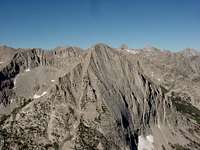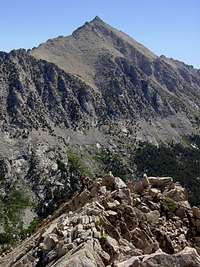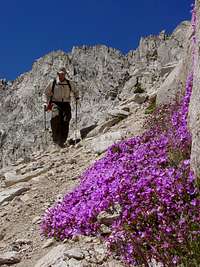|
|
Mountain/Rock |
|---|---|
|
|
36.74400°N / 118.3997°W |
|
|
Tulare |
|
|
Scrambling |
|
|
Summer, Fall |
|
|
12356 ft / 3766 m |
|
|
Overview
East Vidette is a striking peak in Sequoia-Kings Canyon National Park, just west of the Sierra Crest at the entrance to the Center Basin area. Along with West Vidette, the peak stands as a sentinel along the south side of Bubbs Creek guarding the canyon drained by Vidette Creek. East Vidette is a prominent landmark along the John Muir Trail and the PCT which run closely along its eastern and northern flanks.Many outstanding peaks in the center of SEKI NP can be viewed from the summit of East Vidette. The Kings-Kern Divide, with Junction Peak, Mt. Stanford, and Mt. Ericsson can be seen to the south, West Vidette and Deerhorn Mtn to the southwest across Vidette Canyon, Mt. Brewer, North Guard, and Mt. Francis Farquhar on the Great Western Divide to the west, Mt. Rixford, Mt Gould to the north, and University Peak, Mt. Bradley and Mt. Keith on the Sierra Crest to the east. The impressively serrated Kearsarge Pinnacles lie nearby directly across Bubbs Creek to the northeast.
The peak was first climbed in 1910 by a Sierra Club party along the popular East Ridge. The East Ridge is class 3. The Southeast Chutes are class 2. The North Side is class 3-4, and a class 4 chute can be found on the west side facing Vidette Creek.
East Ridge - class 3 The East Ridge rises at a moderate angle from Bubbs Creek to the summit. The rock quality is fair to good. Navigation is easy as there are many variations and options available. A few gendarmes along the route are easily bypassed. This seems to be the most popular route used by most parties.
Southeast Chutes - class 2 Secor describes this route as the Southeast Chute, but there is more than one on this heavily fractured side of the peak. There are many class 3 possibilities as well. The chutes are filled with sand and talus - enough to make an ascent tedious, but not enough to make a descent fast or enjoyable. Secor's recommendation as a "good descent route" seems to lack merit. It's faster than descending the East Ridge, but it's far from "good" and hardly noteworthy as such. The descent chutes are most obvious from above. If ascending from below, follow the faint use trail through the sandy sections at the bottom to one of the useable chutes, after first following along the small creek the drains the southeast side of the peak.
Getting There
The shortest and easiest approach to East Vidette is from Onion Valley on the east side of the crest, about 10 miles on good trail. Take the Kearsarge Pass Trail over the pass, past Bullfrog Lake to the PCT/JMT junction. Descend the PCT for 1,200 feet to Lower Vidette Meadow, then east to Vidette Meadow as the trail follows Bubbs Creek upstream. East Vidette looms high you to the south on the far side of the meadow. You can leave the trail at Vidette Meadow for access to the North Ridge/Face, or continue up the trail for another mile to the start of the more popular East Ridge.East Vidette can also be reached from the west via Roads End near Cedar Grove. Follow the Bubbs Creek Trail upstream for 14 miles and 4,500 feet of gain to Vidette Meadow.
Red Tape
Overnight visits require Wilderness permits.$20 entry fee to SEKI NP if entering from the west.
For full details on regulations and restrictions, see the Eastern Sierra Logistical Center for an east side approach, or the Cedar Grove Logistical Center if coming from the west.
Camping
Camping is allowed in most areas of SEKI NP surrounding East Vidette. Good sites can be found on the north and east sides of the peak along Bubbs Creek. Mosquitoes can be quite abundant in this area through July, so choose a site wisely. There are drier sites higher on the east side of the peak with water flowing through August that may be more tolerable when mosquitoes are troublesome. Camping in the vicinity of Bullfrog Lake is not allowed.There is camping at the both the Onion Valley and Cedar Grove trailheads. See the logisitical center links in the Red Tape section for more information.
Open fires are not allowed above 10,000ft (Vidette Meadow is just below this elevation).
Etymology
Also West Vidette, Lakes, Creek, Meadow"'Two of these promontories, standing guard, as it were, the one at the entrance to the valley and the other just within it, form a striking pair, and we named them the Videttes.' (C. B. Bradley in SCB 2, no. 5, Jan. 1899: 272.) The more common spelling is 'vedette,' meaning 'a mounted sentry in advance of the outposts of an army.'
Bradley, on his sketch map, gave the name 'Deerhorn Creek' -- because it flowed from the base of Deerhorn Mountain -- to Vidette Creek. The creek had its present name on the first Mt. Whitney 30' map, 1907. J. N. LeConte used the
name 'Vidette Meadow' in 1900 (Sunset Magazine 5, no. 6, Oct. 1900: 280), but it didn't get on the USGS maps until 1953. The lakes are first named on the 15-minute quad, 1956."
- Peter Browning, Place Names of the Sierra Nevada




